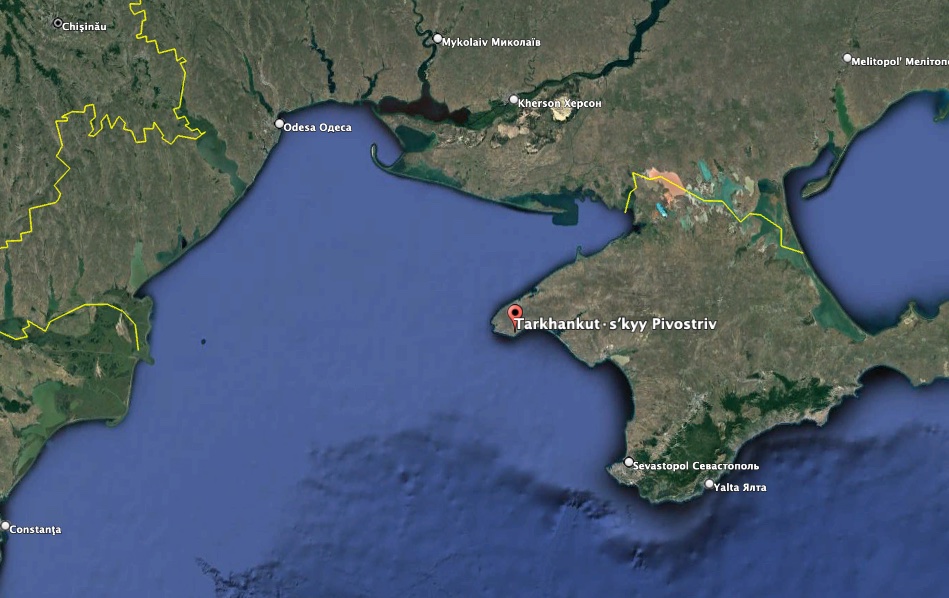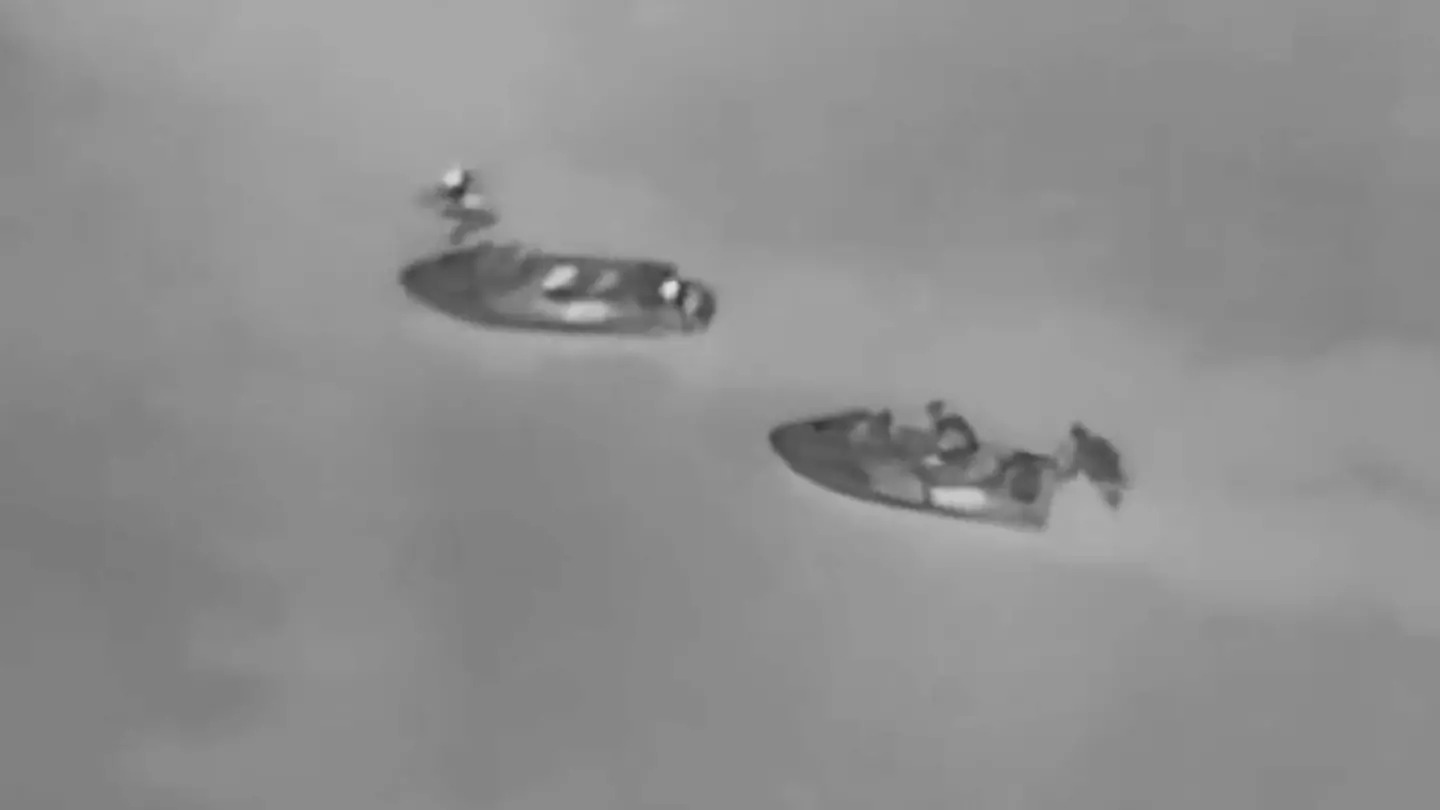Ukraine’s Defense Intelligence Directorate (GUR) released new video Wednesday showing what it claims is a raid on the Russian-occupied Crimean peninsula.
The 73-second video opens with a drone view of at least eight jet skis each with two men aboard approaching the shoreline. As they get closer, several troops disembark and push the jet skis to the shore. The video closes with soldiers holding up a Ukrainian flag as gentle waves lap at their feet.
The “Stugna” and “Brotherhood” units, which belong to the “Timur” special unit of the GUR, “landed on the territory of the Crimean peninsula and inflicted fire damage on the Moscow occupiers!,” GUR said in a tweet. “Crimea will be Ukrainian! Glory to Ukraine!”
The Russian Defense Ministry did not comment on the video, but the Russian-installed leader of Crimea on Wednesday addressed a raid on Crimea.
“I thank the employees of the FSB Border Service for their effective work in stopping the penetration of an enemy sabotage and reconnaissance group into the territory of the Republic of Crimea,” Sergei Aksenov wrote Wednesday on his Telegram channel without offering any specifics of when the raid took place. “One of the saboteurs was captured and is already confessing. Every violator of our borders will face inevitable punishment.”
The official Russian RIA Novosti news agency published a video claiming to be an FSB interrogation of one of the troops captured in that mission.
“A Ukrainian saboteur captured in Crimea said that the group consisted of 16 people and was supposed to film materials about the ‘entry’ into the peninsula,” RIA Novosti said Wednesday on its Telegram channel.
The GUR video released Wednesday, which contains no battle scenes, is undated and we have not been able to geolocate it. GUR spokesman Andrii Yusov said the raid in the video released today took place recently.
“We do not comment on Russian propaganda,” he told us when we asked him about the claims that the FSB captured one of its troops. “But Ukraine will make all necessary efforts to return every prisoner.”
According to Euromaidan Press, Yusov said that after completing the task and inflicting numerous losses on the enemy, the group of special forces withdrew. He said the Ukrainian group also had certain losses, but they are “incompatible” with those inflicted on Russian forces.
“Several groups of Ukrainian fighters worked on the western coast of Crimea,” he told us Wednesday.
This appears to be at least the second raid on Crimea the GUR claims it conducted. It previously said it conducted a raid on Crimea Aug. 24, which you can read more about in our initial story here. At the time, GUR released a 56-second video of that raid, which you can see below.

While Yusov told us that the Aug. 24 raid was a separate mission, it is very similar to a description of that raid by those same units given to the Times of London last month by four of its participants. We cannot independently verify if this video is from a new raid or the one in August, or either.
“Ten jet skis crept towards the coast in darkness, their engines barely audible over the slapping of waves. Each carried two Ukrainian frogmen, invisible against the night sky. The Russians never saw them coming.
Slipping ashore in Crimea, the soldiers readied their rifles, explosives and anti-tank weapons. They had already traveled 125 miles over sea from the nearest Ukrainian-controlled territory and would have to return another 140 miles at speed.
They were the first Ukrainian troops to set foot on the Crimean peninsula in nearly a decade.”

According to the Times of London, Budanov called for the operation as a way of planting the Ukrainian flag on the soil of Crimea for the first time since its 2014 occupation. He also wanted to send a message to Russia, Kyiv’s troops conducting the counteroffensive and allies alike that Ukrainian soldiers could strike anywhere, anytime.
The date of the operation was timed for Ukraine’s second Independence Day after the full-scale invasion.
After a month of training, 20 men made the journey across the Black Sea.
“Our first target was an electronic warfare station so powerful not even a compass could work within 20 miles of the shore,” Borghese, the battalion commander who co-ordinated the mission on the day, told the publication. “It interfered with the work of our missile operators and the entire GPS system could not work. Our guys were working only by the stars.”
As they made their way toward their objective, five Ukrainian support ships raked the shoreline with machine gun fire and rockets to draw attention.
The frogmen “were headed for a base housing an electronic warfare station, which also contained surveillance equipment and radars. Their goal was to place explosives, depart and detonate, but as they got to within 200 meters of their target one of the teams was spotted.”
That forced the raiders to go to their backup plan. Instead of blowing up the building with the explosives they were carrying, they fired anti-tank weapons and rocket-propelled grenades at the building and three Russian support vehicles there.
After about 10 minutes, the frogmen returned to their jet skis and began their escape, harassed along the way by Russian aircraft and vessels. A Ukrainian support vessel that was going to pick them up had to flee the Russians, forcing the raiding party to travel the entire way across the Black Sea.
The party returned safely, according to the Times of London. The GUR also stated that in a video it released at the time which you can see below..
According to the Times of London, the men claimed that the raid was such a success in taking out Russian sensors monitoring the coast that it helped pave the way for future cruise missile attacks on Sevastopol.
One on Sept. 12 struck two Russian Navy vessels, the Kilo class diesel-electric attack submarine Rostov-on-Don (B-237) and the Ropucha class landing ship Minsk. Images later emerged showing the extent of the damage to the submarine.
A second attack took place Sept. 22 on the headquarters of the Black Sea Fleet. Dozens of Russian naval officers were said to have been killed by that strike. You can see a Storm Shadow cruise missile hitting the building in the video below.
The Aug. 24 raid GUR raid on Crimea followed an attack the previous day that GUR said destroyed an S-400 Triumpf surface-to-air missile system in the area.
The GUR released a video at the time showing what it said was the attack on the S-400.
Cape Tarkhankut, where that system was located, was a key location for Russia’s air defense umbrella over the region. Taking out the S-400 system there likely contributed to the success of the GUR raid.
“Cape Tarkhankut was an ideal location for such a system and taking out this battery would potentially open a hole in Russia’s air defense overlay of the peninsula and the northwestern Black Sea. Its destruction would have lowered the risk of the raid. There are also reports yesterday, so far unconfirmed by any official agency, of an attack on a Russian K-300P Bastion-P coastal defense missile system that launches P-800 Oniks anti-ship cruise missiles in that same part of Crimea. Hitting that system there, if that occurred, could have also been critical to the success of the special operations raid.”
Unlike the follow-on attacks on Sevastopol using Storm Shadow and/or SCALP-EG air-launched cruise missiles, the strike on the S-400 system was carried out by a Neptune anti-ship missile Ukraine had modified to carry out land attacks. You can read more about that in our original story here.
Ukrainian intelligence also claimed there was another attack on an S-400 system in Crimea on Sept. 14, this time with missiles and drones on an installation near the town of Yevpatoriya, about 40 miles southeast of the previous attack. You can read more about that in our coverage here.
In an exclusive interview with The War Zone during his visit to Washington D.C. last month, Budanov told us that Ukraine has been intensifying attacks on Crimea since the middle of August and that they were aimed in large measure at air defense systems to create such holes in coverage.
“That is why, naturally, when we engage in another and another air defense battalion of the Russian military, they need to think about where they can pull those systems from and where are they able to tolerate less defenses in other places,” he told us. “The second point in engaging defenses is that we’re making those holes in the overall air defense coverage. Those holes are exploited for other things…”
After attacks on Russian naval assets in the Black Sea, on Crimea and near the Black Sea port of Novorossiysk, Ukraine’s military said that the Black Sea Fleet is not venturing much beyond Cape Tarkhankut.
“The front line in the sea has long been pushed back at least 100 nautical miles from the coast controlled by Ukraine,” Ukrainian military spokesperson Natalia Humeniuk said on national television Wednesday. “Currently, ships and boats of the Black Sea Fleet of the Russian Federation do not actually sail in the direction of the territorial sea of Ukraine. From time to time, they appear near the coast of Crimea, but not closer. They do not dare to go beyond Cape Tarkhankut.”
The War Zone could not independently verify that claim.
We cannot say for sure exactly what was accomplished in the raid depicted in the video released today, or even say with certainty it took place in Crimea as claimed. Clearly, however, Ukraine has already carried out attacks on the peninsula that have helped clear the path for its donated cruise missiles and homegrown Neptunes to have a significant impact on the Russia’s Black Sea Fleet..
Contact the author: howard@thewarzone.com
